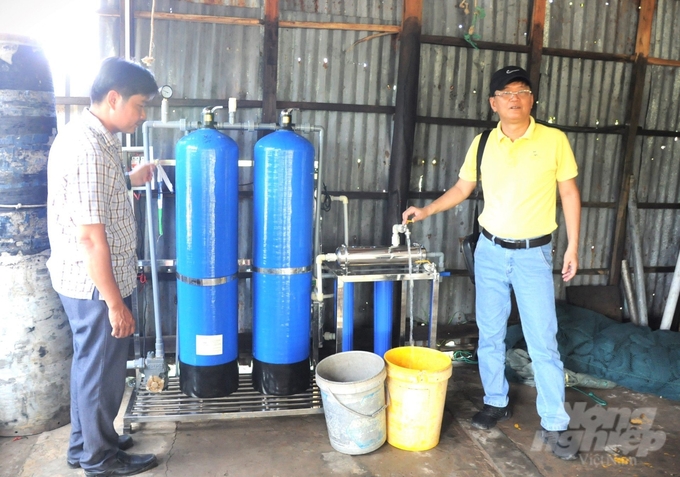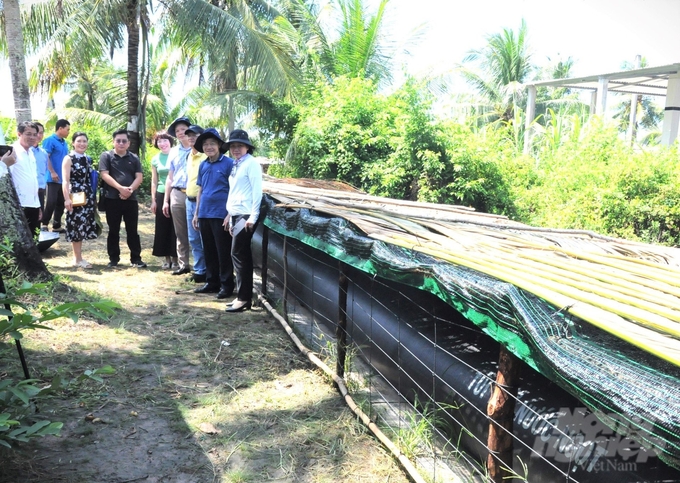May 28, 2025 | 11:58 GMT +7
May 28, 2025 | 11:58 GMT +7
Hotline: 0913.378.918
May 28, 2025 | 11:58 GMT +7
Hotline: 0913.378.918

Mr. Nguyen Tai Ky's household in Minh Co Hamlet, Van Khanh Dong Commune, recently installed a cluster model capable of providing water to three to five neighboring households. This system is equipped with a water purification standard, allowing for direct consumption. The model features a simple installation process and ease of use. Photo: Trung Chanh.
Mr. Ky's household was chosen to participate in the project titled "Research and proposal of technological solutions for Water Supply in Households and Small Communities in response to drought and saltwater intrusion in the coastal provinces of the Mekong Delta region." The project is deployed in Kien Giang province by the Center for Consultancy and Technology Transfer in Water Supply and Environmental Sanitation under the National Center for Rural Water Supply and Environmental Sanitation, Ministry of Agriculture and Rural Development.
We followed a task force comprising officials from the Ministry of Science and Technology and the Ministry of Agriculture and Rural Development to Van Khanh Dong Commune, An Minh District, Kien Giang Province. We were tasked with assessing the effectiveness of the household and small community water supply system in the context of drought and saltwater intrusion in the coastal provinces of the Mekong Delta region. Despite it the rainy season, the marks of saltwater intrusion were visible on various structures within these provinces, and corrugated iron walls showed signs of rust and corrosion.

The research project aims to identify low-cost solutions and technologies for collecting and treating rainwater and surface water, which will enable decentralized water supply solutions for individual households and small communities to adapt to drought and saltwater intrusion in the coastal provinces of the Mekong Delta region. Photo: Trung Chanh.
Despite access to a drilled groundwater well, Mr. Nguyen Tai Ky's household in Minh Co hamlet, Van Khanh Dong commune was unable to use the water source due to its high salinity. The surface water from the river was turbid, and during the dry season, it became brackish, as it was located one kilometer from the sea. Similar to many other households in the area, Mr. Ky invested in multiple cement tanks to store rainwater for daily use.
According to Mr. Ky, his family is forced to buy additional fresh water brought in by boats every dry season at a cost of 40,000 VND per tank, which is equivalent to 1 cubic meter. "Despite our efforts in saving water, our family of four uses at least 1 cubic meter of water every week. In a single month, the cost of purchasing extra water is estimated at around 200,000 VND. Although this water source is relatively unclean, we have limited options," Mr. Ky voiced of his concerns regarding freshwater shortages during the dry season.
Fortunately, Mr. Ky's family was selected and received support from the local government to install a rainwater harvesting and filtration system for daily use. This system is designed as a cluster model, capable of supplying water to three to five neighboring households. According to Mr. Ky, the standardized model produces clean and portable water, Additionally, it features a simple one-day installation process and ease of use. Thanks to extensive guidance, households can easily operate and manage the system without encountering significant difficulties or complications.
According to Mr. Nguyen Van Ti, Vice Chairman of the Van Khanh Dong Commune People's Committee, there are five models currently installed within the commune, including one cluster model and four individual household models. There are a total of thirty-one models installed across Kien Giang province.
During the installation process, and through ongoing monitoring and assessments, these models have been well-received by local residents. The filtration equipment operates efficiently, enabling timely water storage during the rainy season. The family household models offer a water storage capacity of, whereas the cluster model offers a 25-cubic-meter capacity. The integration of rainwater and surface water treatment and storage encourages local residents to proactively ensure a year-round supply of freshwater for their daily needs.
Mr. Pham Quoc Hung, Deputy Head of the Rural Clean Water Management under the Department of Water Resources, emphasized that certain aspects must be considered to ensure the widespread implementation of these models in practical contexts. These aspects include a comprehensive evaluation of costs, which encompass pumps, valves, pipes, and other necessary components of the pilot model, to ensure that the costs can be set as a reference framework to support installation. Additionally, the filtration equipment should be categorized into separate items for singular use, storage, and treatment, allowing residents the flexibility to choose investments that align with their specific requirements, without the obligation of installing an entirely new system.
A workshop was held on October 14 in Rach Gia City, Kien Giang province to introduce and disseminate the results of the project "Research and proposal of technological solutions for Water Supply in Households and Small Communities in response to drought and saltwater intrusion in the coastal provinces of the Mekong Delta region."
This research project, funded independently at the national level, was carried out under the supervision of the National Key Program Coordination Office and the Department of Science and Technology for the Economic and Technical Sectors, under the Ministry of Science and Technology. The project was assigned to the Center for Consultancy and Technology Transfer in Water Supply and Environmental Sanitation to implement, under the leadership of Assoc. Prof. Dr. Nguyen Van Tinh, who serves as the Project Director.

Professor Dr. Nguyen Van Tinh, the Project Director, presenting his report during the workshop held to introduce and disseminate the results of the project "Research and proposal of technological solutions for Water Supply in Households and Small Communities in response to drought and saltwater intrusion in the coastal provinces of the Mekong Delta region." Photo: Trung Chanh.
According to the report on project implementation, the project was carried out over a 24-month period between December 2021 and November 2023. The project owner collaborated with the Center for Clean Water and Rural Environmental Sanitation in Kien Giang and Bac Lieu provinces, as well as the district-level Department of Agriculture and Rural Development, and the local governments in various communes to conduct surveys, select sites, and install a total of 62 water collection, storage, and filtration models in households. Most notably, two community-scale models were installed capable of supplying water to three to five households.
The project installed 31 models in Phuoc Long town, Phuoc Long district, and Loc Ninh commune, Hong Dan district in Bac Lieu province. Similarly, 31 models were installed across seven communes, including six coastal communes in An Minh district and the Phu My border commune in Giang Thanh district, Kien Giang province.
During the 2019-2020 dry season, approximately 3.3% of the population in the region faced water shortages for daily use. Accordingly, over 75,000 households in rural areas lost access to water supply infrastructure. The widespread implementation of this project has the potential to alleviate water scarcity and provide fresh water during the annual dry and saline periods for a considerable number of households.
As a beneficiary province, Mr. Vu Thanh Trung, Deputy Director of the Center for Clean Water and Rural Environmental Sanitation of Bac Lieu province, assessed that the project's household water supply model is highly practical and yields significant benefits. The abundant and unpolluted rainwater can serve as a reliable source of household water in areas prone to drought and saltwater intrusion. Many rural households in Bac Lieu province currently lack access to clean water, making the expansion of this model crucial in the near future.

Officials from the Ministry of Science and Technology and the Ministry of Agriculture and Rural Development conducting a survey and assessment of the effectiveness of household and small community water supply models in the context of drought and saltwater intrusion in coastal provinces of the Mekong Delta region. This initiative was carried out in Kien Giang province. Photo: Trung Chanh.
Mr. Nguyen Thanh Binh, Director of the Center for Clean Water and Rural Environmental Sanitation in Kien Giang province, highlighted that Kien Giang province's extensive territory and sparse rural population, especially along the coast and islands, render investment in centralized water supply infrastructure a significant challenge. Only 37% of the local rural households currently have access to clean water. Consequently, this model is highly suitable for isolated single households on islands, coastal areas, and border regions due to the model's cost aligning with the income of the local population as well as its relative ease of use.
According to Dr. Do Minh Nhut, Deputy Director of the Kien Giang province's Department of Science and Technology, it is not feasible or cost-effective to extend electricity and water supply over long distances to serve only a few households in remote and sparsely populated areas. As a result, implementing small-scale, low-cost models is a practical solution that fulfills the needs of local residents and contributes to achieving the criteria for new rural area construction.
Mr. Nguyen Tien Tai, Deputy Director of the Department of Science and Technology for the Economic and Technical Sectors under the Ministry of Science and Technology, emphasized the urgency of the research project. It addresses the practical needs of various households in the coastal areas within the Mekong Delta region, who often face severe water shortages during the dry season. The research outcomes is expected to be applied in real-life situations, meeting the needs of the local population and being replicable in similar regions.
According to Prof. Dr. Nguyen Van Tinh, the research project is directed at small and remote households living in coastal and border regions that are vulnerable to drought and saltwater intrusion. These households lack centralized water supply systems. The project's aim is to identify low-cost solutions and technologies for collecting and treating rainwater and surface water, which will enable decentralized water supply solutions for individual households and small communities to adapt to drought and saltwater intrusion in the coastal provinces of the Mekong Delta region. The project prioritizes using locally-sourced and environmentally friendly materials, and applying simple, science-based technologies that are accessible to low-income rural households. According to assessments, the project is highly practical and responsive to the needs of the local population, resulting in high replication feasibility.
Translated by Nguyen Hai Long
/2025/05/25/4127-3-073637_820.jpg)
(VAN) Thanks to the promotion from an FAO-implemented project, vegetable production in greenhouses in Moc Chau has seen strong development, from 1.5 hectares in 2021 to nearly 50 hectares in 2024.

(VAN) FAO has recently supported USD 140,000 to implement the project 'Risk mitigation human-animal interface risks through disease control initiatives in pig farming.'

(VAN) The People's Committee of Tra Vinh province has approved an adjustment to the investment policy for the Green Hydrogen Plant project, increasing its area to approximately 52.76 hectares.
![Reducing emissions from rice fields: [2] Farmers’ commitment to the soil](https://t.ex-cdn.com/nongnghiepmoitruong.vn/608w/files/news/2025/05/05/dsc08881jpg-nongnghiep-140632.jpg)
(VAN) Clean rice cultivation model in Thuong Tan commune, Bac Tan Uyen district, is assisting local residents in achieving sustainable agriculture by substantially reducing costs, increasing productivity, and protecting the environment.

(VAN) At the conference to disseminate Resolution No. 68, AgriS introduced its digital agricultural ecosystem and reaffirmed its commitment to accompanying the Government in promoting private sector development and sustainable agriculture.

(VAN) 'Blue Ocean - Blue Foods' initiative is designed to restore marine ecosystems and establish sustainable livelihoods for local communities by cultivating a minimum of 1,000 hectares of cottonii seaweed in the first three years.
/2025/05/21/4642-3-112707_603.jpg)
(VAN) The V-SCOPE project has made direct contributions to three out of six pillars of the Comprehensive Strategic Partnership between Vietnam and Australia.